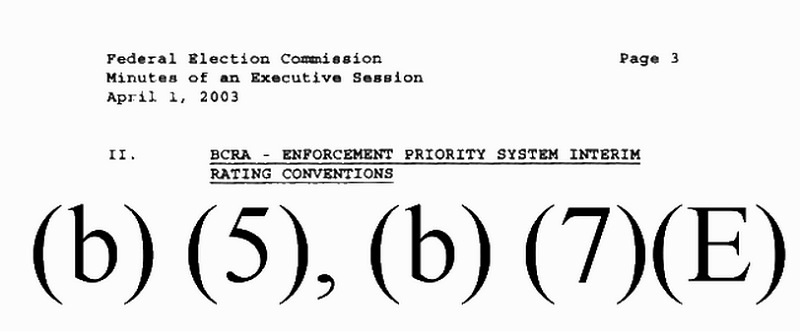Of the 34 pages that make up the Federal Election Commission Status of Enforcement report produced for the second quarter of this year, only nine contain meaningful information. Two or three more include unredacted table headers and a fourth is the title of the report itself.
Most of the remaining pages have been withheld under FOIA section (b)(5), an exemption intended to allow “deliberative process” without lawmakers worrying about the public looking over their shoulder at every rough word. While the goal of promoting frank and open discussion around matters of policy is a laudable one, exemption (b)(5) has come to be known as the “withhold it because you want to” exemption because of how broadly it can be interpreted in some cases.
This is one of those cases.

The contents of Status of Enforcement reports are laid out on the regulator’s website. They are separated into four sections: statistical performance information, a list of year-old enforcement matters that haven’t been considered by the commission, a list of enforcement matters that are within five years of their statute of limitations, and a list of enforcement matters that the FEC has considered and decided to investigate. While the document in question may contain lists and statistical information that members of the agency would prefer not to be disclosed, this is not a document that contains deliberative discussion.
This is not the first time that the FEC has withheld documents under an overbroad interpretation of exemption (b)(5). In March of this year, MuckRock tried to obtain the agency’s Enforcement Priority System, a criteria set that determines which cases the FEC is interested in pursuing and which should be discounted early on. Citing (b)(7)(E) and (b)(5), the regulator withheld the EPS and cut out any useful information from the meeting in which the criteria contained in the EPS were decided upon.

In 2013, MuckRock attempted to obtain the FEC’s guidelines for when to apply the (b)(5) exemption, along with those of several other agencies. Performing a FOIA exemption maneuver that could appropriately be described as Kafka-esque, the FEC attempted to withhold those guidelines under exemption (b)(5). The agency later reversed its decision upon appeal, noting that it had discovered the document on the public part of its own website.
The FEC’s decision to withhold more of the document than might be considered lawful aside, there were still some insights into the workings of the agency. By and large, the information left unredacted supports what Chairwoman Ann Ravel said about the commission in May of this year: that the FEC is “worse than dysfunctional.”
The first real piece of information in the Q2 Status of Enforcement report is a small collection of tables detailing the number of days taken to dismiss low-rated matters. Incidentally, we are unable to describe what those low-rated matters might be, because those matters are rated under the Enforcement Priority System that the agency has declined to release. What is visible from this data is that the FEC is now taking over three times as long to dismiss even the matters that it rates as unimportant.

Another interesting graph is the number of “Matter Under Review” files the FEC has received per year. The commission doesn’t have to decide that your case is worth pursuing, or even that there has likely been a violation, in order to qualify a complaint as an MUR - you simply need to fill out the paperwork correctly. Bear in mind that the FEC’s MUR spike in the years after an election year. (Note: the figure for 2015 is projected based on y.t.d. figures.)

While this data set is limited by a small number of years considered (earlier reports also do not contain information on MUR receipts before 2010), it does look like a pattern is emerging. MUR receipts are still considerably higher the year after an election, but there are fewer overall in each subsequent two year grouping. If what Ms. Ravel said is true, and the FEC really is dysfunctional, it is not surprising that fewer complaints are being made to the FEC - the public no longer expects the agency to carry out its duties.
The reason for dysfunction in the FEC is clear. Unlike other agencies, it is caught in perpetual partisan gridlock by design - no party may control more than three of the commission’s six seats. In the American two-party system, that means that the two dominant parties have to find common ground for the agency to do its job. Unfortunately, the issue of whether many of the laws that govern our elections should be enforced at all has itself become a partisan issue in some circles.
Regardless of your stance on election laws in the U.S., the need for the laws currently on the books to be enforced should be obvious. A failure to enforce the rules opens the door to chaos in the system by which we elect our officials. Lawlessness here benefits no one.
Read the report on the request page, or embedded below:
Image via GSA.gov




